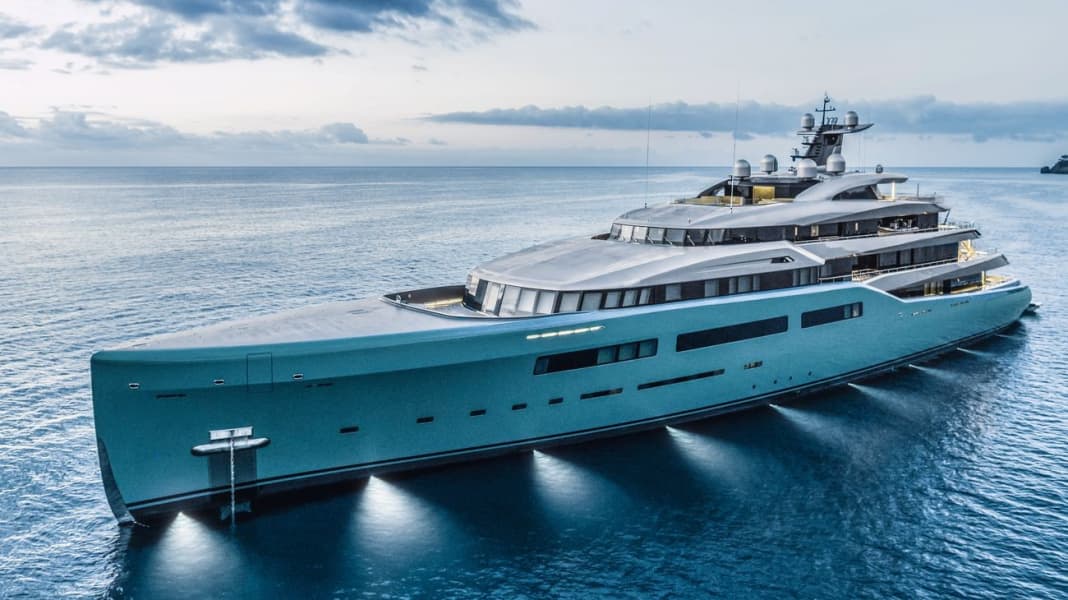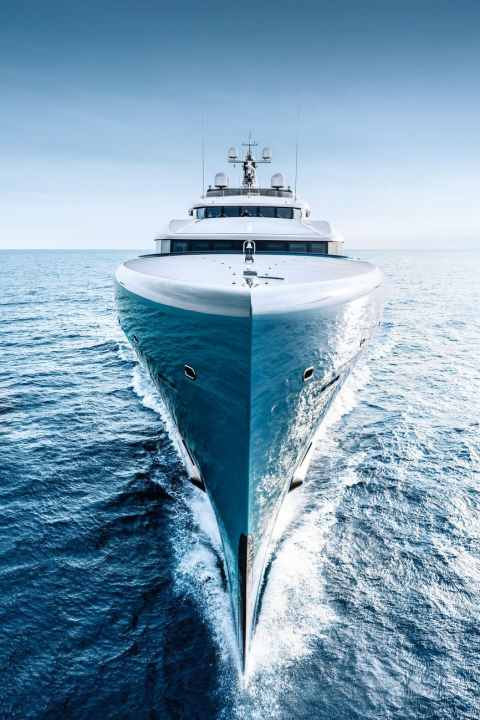
After almost ten years on his "Aviva", the owner decided to expand once again. What could be more obvious than finally aiming for the round 100 metre mark? It turned out to be exactly 98.40 metres. There is a sporting reason for this.
With the latest "Aviva", his third, the owner is one of the "repeat offenders": his first "Aviva" was a Feadship, the second had already been delivered to him by Abeking & Rasmussen, the shipyard on the Weser: built in 2007 and 68 metres long. The Lower Saxons took care of the construction and interior, Reymond Langton took care of the exterior styling.
His yachts are not used by the owner - whose name is Joe Lewis - as pleasure boats, but as a mobile office and gallery for his art collection. His home is in the Bahamas, but the British businessman - investor, art collector and majority owner of Tottenham Hotspur, born in 1937 - lives on board with his staff for up to ten months of the year.

This is another reason why the crew of twelve guests numbers 35. A repeat offender: what better endorsement for the shipyard and designers? For the exterior, the owner once again engaged the services of Reymond Langton from the small town of Bath.
With the almost 5000 GT of the new "Aviva", A & R built the most voluminous of all yachts of the format around 100 metres for Lewis. She owes her cubic metres of converted space not least to the sporting ambition of her owner.
In the hull, he and his guests have access to a 200 square metre padel tennis hall over six metres high, a unique structure on the water.

The all-round bulbous design of the hull is based on extensive tank tests and guarantees 20 per cent less resistance than conventional shapes.
A top speed of 20 knots therefore requires less engine power, which also results in significantly reduced fuel consumption. The crowning glory of this design is a hybrid drive: With electric motors, "Aviva" still runs at up to 11 knots without the main drive, a smooth and quiet solution.
In order to build "Aviva", a new hall was needed on the Weser. The shipyard had to prepare an ingenious solution to be able to launch it. A Norwegian pontoon was moored in front of the new construction hall. A hydraulic trailer on 60 wheels, together with a winch, moved the 98 metres onto the floating body.

A & R had been planning the event for weeks. The event will probably remain unforgettable for everyone involved. Sales Manager Till von Krause is more than satisfied: "We are proud of 'Aviva'. She is the result of the best shipyard work and first-class communication between the owner and his team during a short construction period of less than three years."
It was not the first time that the owner had chosen Toby Silverton as his representative. "We worked closely with him again," recalls Andrew Langton. "He had a lot of experience in automotive design, was familiar with aeroplanes and also shipbuilding.
He mobilised all his passion for the new 'Aviva' to give it its own face. It was really rewarding to work with him again."
The key to understanding the design brief was the generous amount of space, not least for the indoor tennis centre. No matter how important the styling and external appearance, unique and elegant appearance were, the functional design of the layout on the decks and the interior fittings took priority. The new "Aviva" was also to be different from its predecessor, even more masculine and deliberately designed to look like a sculpture.

The key terms of the briefing? The bulbous bow, the designers explain, is part of the mandatory programme, as it was on the previous "Aviva", and not for aesthetic reasons, but for stability and behaviour in rough seas. Toby Silverton and the shipyard designers worked together on the hydrodynamics, slim in the bow area and unusually tapered aft at a width of 17 metres, for purely hydrodynamic reasons.
The aerodynamics of the superstructure should ensure that exhaust fumes are kept as far away from the yacht as possible. In addition, the superstructures with large windows were to allow generous views from the inside to the outside. The owner favoured fold-out balconies and an upper private saloon whose walls can be opened completely.
All the details of the hull were to fit in with the hydrodynamic curves of the underwater hull. The superstructure, on the other hand, was to contrast with the hull, appear crisp and multi-faceted and at the same time hide the volume with slender and dynamic lines. A feat of magic was therefore required.

And then the realisation began, in all modesty. "We started with a blank sheet of paper," says Reymond Langton about the initial considerations. The challenges also included the fact that no more than six months were available for the complete design, styling and interior, "half the time we would normally have to spend on a yacht of this size".
This was due to the fact that the entire order was scheduled to take one year less than usual for a project of this size: just three years. "From the signing of the construction contract to the delivery of the complete exterior styling, a 3D computer model and a built model for approval by the owner, we had just two months."
The main task during this short time was to accommodate the mass of 5000 gross tonnes of volume, including the tennis hall, over a length of 100 metres and still make the yacht look long and slim. "And then the design not only had to be different from its predecessor, but also unique."
What should you do in such a stressful situation? Keep calm and take breaks. The Reymond-Langton team therefore adopted a methodical approach. The first considerations were the length and side lines of the freeboard. They run from bow to stern without interruption with only one step under the mast, emphasising the length.
The designers summarised the crew accommodation windows in the bow as bands. Andrew Langton, Pascale Reymond and Jason Macaree designed the hull to be smooth and clear with no rubbing strake or other interruption to the surface that would detract from the effect of the length.

The superstructures do without the so-called fashion plates between the decks as on the previous "Aviva". The design achieves sculptural effects through interrupted masses, which also create a certain lightness. Bevelled facets on the sides of the decks create shading. "Some of these design elements are clearly influenced by the shapes of the Lamborghini Sesto Elemento."
The decks and the wind deflectors on the sundeck always end in glazing without any seams. The views from inside to outside remain uninterrupted. In both salons, the windows extend from floor to ceiling.
For the upper lounge, Joe Lewis wanted a completely uninterrupted view: The glass side walls can be opened over a length of nine metres.
The aerodynamics were improved by bevelled windscreens on the bridge. Following tunnel tests, Silverton replaced the usual bulky mast and equipment carrier with a shape that he copied from aeroplane wings. "The mast grows out of the superstructure instead of appearing superimposed: a flowing and holistic look."

A & R painted "Aviva" in four colours. The blue hull does not act as a harsh, bright contrast to the sea as usual; the blue colour reduces the effect of the height and stretches the hull. The light metallic silver of the superstructure reflects the sky and also visually reduces the volume.
The black of the window strips clarifies the design and emphasises the horizontal. "Finally, a dark metallic grey on the mast details and at the end of the superstructure is one of the tricks we used on the previous 'Aviva'." The eye follows the silver of the superstructure and not the true length of the deck.
The decking is a complete departure from the usual. Joe Lewis explains his aversion to a classic teak deck with the words "We're not on the 'Titanic' here". On board for months, he cannot stand the black sika strips between the timbers. The result is called Esthec in various patterns that match the floor patterns of the interior on the outer decks.
But why an indoor tennis centre? Joe Lewis wanted one because the gym on his previous "Aviva" had become too boring for him. In the meantime, he had discovered padel tennis on land. The new hobby has changed his life: Since then, wherever he goes, there is a padel tennis court to be found, in his houses and of course on the new "Aviva".
Travelling to padel courts on land in the Balearic Islands and the south of France by tender had restricted his passion too much. He plans to travel to the South Seas, Australia and the US coasts with his padel racket and without having to search for courts first. So it was the fast sport that prompted him to build his new home in the first place. So Joe Lewis can also "paddle" off Sydney and San Francisco.
This article comes from BOOTE EXCLUSIV issue 4/2018.

